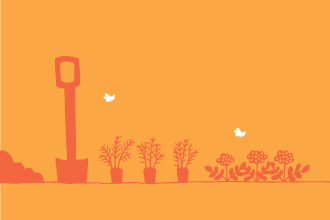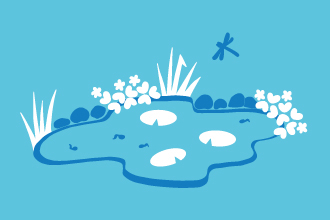Shropshire in Summer
JUNE, JULY AND AUGUST
As we settle into the long, hopefully warm, days of summer we all want to be outside as much as possible, feeling the sun on our skin and watching nature in its full glory - ripening cornfields with poppies through them, flowering hay meadows, hedges lined with a froth of cow parsley, gardens full of butterflies and hills turning purple with blooming heather.
June is the best month to take a walk in an old-fashioned hay meadow.
Melverley Meadows
The grasses are still low enough to see the flowers, and many of the most iconic species are in full bloom. Traditional meadows comprise many species of grass, beautiful in their own right, but set off by typical meadow flowers such as hay rattle, eyebright, pignut, betony, tormentil, hawkbit, knapweed, devil’s bit and sneezewort, with orchids adding a bit of extra glamour.
Damper patches support ragged robin, marsh marigold, meadowsweet and bugle.
Visit Melverley Meadows reserve in June for a real treat, when swathes of common spotted and heath spotted orchids will be flowering, and then go back in July to see the later flowers such as spiny restharrow and devil’s bit. Find out more about Melverley by watching the video below.
Other flower-rich grasslands are Button Oak Meadow and Farfields Meadows.
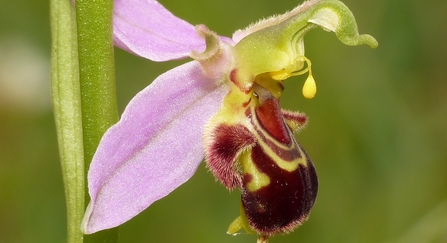
Bee orchid (c) Janet Packham Photography
Several of our reserves are superb places to see other orchids. Try Button Oak Meadow for marsh orchid, Sweeney Fen for fragrant orchid and marsh helleborine, Llanymynech Rocks for bee orchid and Llynclys Common for greater butterfly orchid and twayblade.
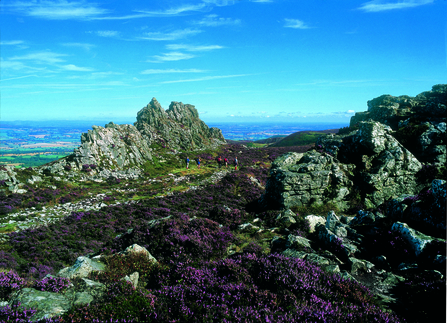
Stiperstones (Ben Osbourne)
Summer is the best time to take a long day out on the Stiperstones. See the results of our Back to Purple project from Nipstone, where conifers were felled to allow upland heath with heather and whinberry to return. Visit in August and gather ripe whinberries for a pie, and go home sun-warmed and spattered with purple juice, with those tell-tale purple lips! Watch out for bilberry bumblebees, emperor moths, wheatears, skylarks and merlins.
Lower Shortditch Turbary is another good spot for whinberries, or try Mason’s Bank near Bishops Castle.
As spring was the season of birds, summer is for insects. Our most colourful species are on the wing and dazzlingly obvious – butterflies, dragonflies and damselflies.
You can see many of the commoner species of butterfly in parks and gardens around the county, but for something a bit rarer, try Bury Ditches near Clun for wood white, green hairstreak and purple hairstreak, the Oswestry hills for fritillaries, skippers, brown argus, white letter hairstreak and clouded yellow or Granville for dingy skipper and green hairstreak.
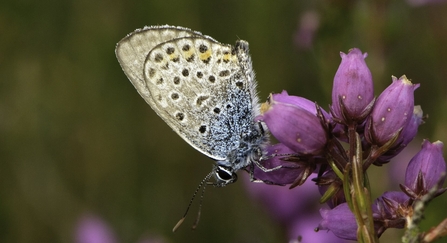
Silver-studded blue butterfly (c) Chris Gomersall/2020VISION
The most exciting butterfly spectacle, though, has to be the silver studded blues emerging on Prees Heath Common – the last sanctuary for the species in the Midlands. The peak flight season is usually late June and July, when thousands can be seen over the heather.
We have 22 species of dragonfly and 12 of damselfly in Shropshire, each a stunning metallic gem, and midsummer is the best time to see them.
Different species prefer different habitats, so to ‘bag’ them all you’ll have to do some exploring. Try Fenns & Whixall Moss for an impressive range, including rare white-faced darters as well as four-spotted chasers, emperor dragonflies, large red damselflies, azure damselflies, common blue damselflies, black darters, emerald damselflies, white-legged damselflies, banded demoiselles, and beautiful demoiselles. Cramer Gutter offers a chance of seeing the spectacular golden-ringed dragonfly and keeled skimmer.
While you’re on the Mosses looking for dragonflies, spend a little time peering into the bog pools to spot one of the weirdest and most iconic species of the mosses, the raft spider.
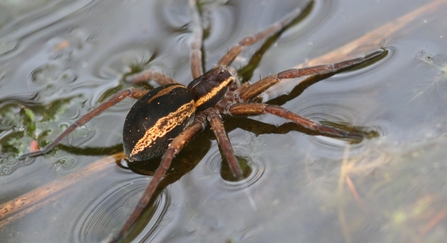
Raft spider (c) Vicky Nall
Wem Moss is a good place to see them – they walk on water! Look for a large chocolate brown spider with creamy yellow stripes down its back sitting, with its front legs resting on the water surface to feel for the vibrations of potential prey. Using the surface tension of the water, it will chase out on to the water to catch its prey, which can be as large as small fish.
The vegetation of the mosses is worth a closer look too. Search out the fascinating insect-eating plants, all bog specialists, making up for the lack of nutrients in the peat by going carnivorous.
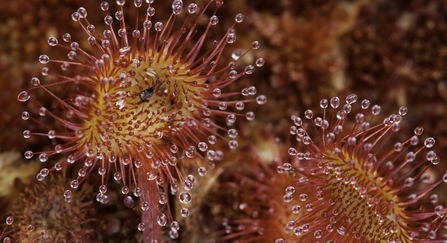
Round-leaved sundew (c) Mark Hamblin/2020VISION
Wem Moss is the only Shropshire site for great sundew and oblong-leaved sundew, while the round-leaved sundew is found all over the Mosses. Sticky hairs on their rosettes of reddish leaves glisten like dew in the sun, attracting small insects to their doom. Catherton Common and Cramer Gutter host another insectivorous plant, the butterwort, with delicate blue flowers above its pale green sticky leaves.
Summer is a great time to go out in the long dusk. Try a walk on one of our reserves as the light fades. Young foxes and badgers might be about, or you could spot bats flittering along hedgerows and around the canopy of trees. Lakes and rivers can produce sightings of daubenton’s bat, swooping low over the water, and tiny pipistrelle bats often appear in gardens. A bat detector is a great gadget to pick them out, or you can just enjoy watching them.
Owls will be out too – barn owls particularly like to hunt at dusk, so you might see the ghostly white shape drifting along a hedgerow or hear its eerie shriek.
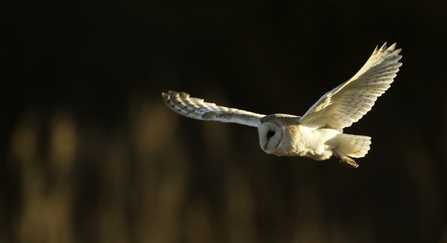
Barn Owl (c) Danny Green/2020VISION
Once it’s truly dark, spend a while star gazing. A clear sky and a new moon give the best conditions to appreciate the night sky, and the Perseid meteor shower in August is spectacular with a shooting star every minute! Nipstone is a good place to watch from.
We have so many places to visit, but don’t forget to enjoy the wildlife in your garden or local park. Now’s the time to sit in the sunshine, relax and revel in the nature around you. You might want to have a think about ways you could attract more wildlife to your garden – perhaps more plants for bees and butterflies, or a pond for dragonflies. Summer is for dreaming as well as doing!
Dr Cath Price highlights some of Shropshire's best summer wildlife and wild places.
Summer blogs
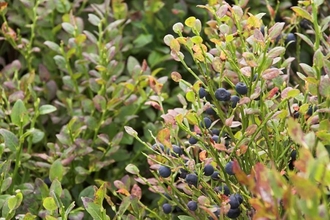
Dr Cath's Nature Notes - August 2023
The first Sunday in August is the traditional start of the whinberry harvest in Shropshire, so I’m heading for the hills – specifically…
Dr Cath's Nature Notes - June 2023
June, for me, is the month of meadows. This is the time they reach their glorious peak, with a tapestry of wild flowers blooming, grass…
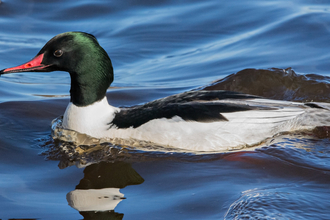
What do birds do on their summer holidays to the UK?
Martin George explains what to expect from our British birds throughout the warmest season.
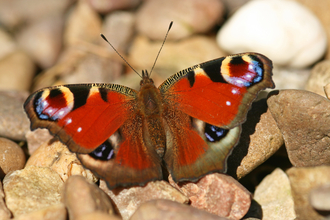
Cath's Nature Notes - July
July is really a month for insects – butterflies and moths, dragonflies and damselflies. I’m thrilled to have seen a large skipper…
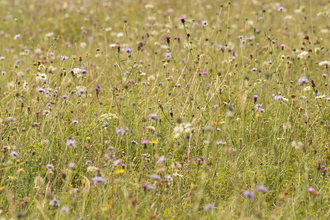
Dr Cath’s Nature Notes – June
June is the beginning of proper Summer for me. The rush of Spring, with all the new arrivals and changes, is over and the season is…
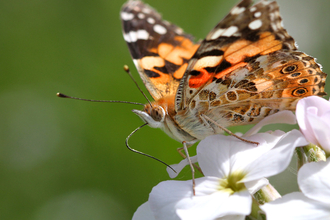
Late summer butterflies
With summer quickly heading towards Autumn the nights are starting to draw in and many of our borders are beginning to flag after…















